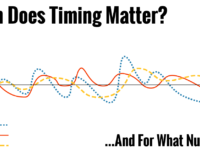I wrote an article about the “ideal” macronutrient ratios for different types of climbing a long time ago—almost four years now! It’s still a good basic overview, but I think it’s time to revisit the topic and provide a little more context. Moreover, I think it might be worth writing an article explaining some of the reasoning rather than just providing some numbers. So that’s what we’ll be covering today!
The Briefest of Overviews of the Macronutrients
Macronutrients are so-called because we need them in relatively large amounts, which is to say we need grams and grams of them (opposed to micronutrients, most of which we need in only micro- or milligram amounts). There are three macronutrients:
Protein: Composed of chains of amino acids, primarily used to build bodily proteins, occasionally used for energy. 4 kcal per gram.
Carbohydrate: Composed of simple sugars (mostly hexoses like glucose and fructose), primarily used for energy, occasionally stored as fat, serves some structural roles physiologically (e.g., the backbones of our DNA, glycoproteins, etc.). 4 kcal per gram.
Fat: Composed of fatty acids of various lengths. Primarily used for energy, often stored as fat, serves numerous physiological roles (e.g., hormones, cell membranes, etc.). 9 kcal per gram.
The goal of a macronutrient ratio is to align each of these three categories of macronutrients with each other and create a hopefully simple dietary plan. For example, if your goal was 25% protein, 50% carbohydrate, and 25% fat, and you had a daily caloric goal of 2,000 kcal, then you could easily arrive at the following targets: 125 g protein (500 kcal), 250 g carbohydrate (1000 kcal), 56 g fat (500 kcal). Then you’d just plan out your day and everything else would be easy! Right?
The Failures of Macronutrient Ratios
Macronutrient ratios are easy to come up with and calculate, but they’re inherently problematic in a few ways. If they’re going to be useful, we need to address these flaws and either fix them or dodge around them.
The Protein Flaw
First, there’s the protein flaw: we don’t really use protein for energy and we don’t really need more protein (at least not to the same extent as carb and fat) as our daily exertion increases. If we put protein into our macronutrient ratio, though, then it ends up being tied to our daily exertion as if it were.
Probably very few of you (or none of you) are professional cyclists who compete in long, high-exertion endurance events, but I like using these types of cyclists as examples because they push the boundaries of caloric need. A cyclist competing in one of these events could burn upwards of 10000 kcal a day, a ridiculous sum. Assuming that cyclist had a relatively normal macronutrient ratio plan of 15% protein, they would need to consume 375 g of protein to reach this goal! Not only is that not practical, it’s not helpful for their performance goals in the slightest.
The seemingly simple solution is to use a much lower protein goal, say only 5%. But now what happens on a rest day, when caloric totals are only maybe 2500? Should they only eat 30 g of protein? Clearly not.
The other solution is to have different ratios for different types of days, so a ratio for a training day, a rest day, a competing day, etc. At this point, though, the simplicity promised by using a macronutrient ratio is rapidly diminishing; it’s not an easy tool anymore.
My solution is to remove protein from your macronutrient ratios completely. Protein, as you may have read once or twice on this site, does not really follow the same “rules” as carb or fat. We need to get a certain amount of it—a threshold, measured ideally per meal—and past that we don’t get much more benefit. That threshold is around 20 g in a single meal, and if we can get at least three but preferably four or five of those types of meals in a day then we can reasonably expect to have fully met our body’s physiological need for protein.
Macronutrient ratios, then, should really only be examining the relative amounts of carbohydrate and fat in your diet. But here we find a potential failure as well…
The Exertion Flaw
Let’s say you determine that your diet should be approximately a 1.5:1 ratio of carb to fat based on your usual intake on a rest day. With a caloric intake of 2400 calories (400 of which go to protein), you end up consuming around 300 g of carb and 90 g of fat. This is a totally reasonable dietary intake of these nutrients, and I wouldn’t blink an eye if you told me that was your normal day.
Now let’s say you go out to the crag for a day. You hike in, spend around six to eight hours climbing, and hike out. Because you want to keep it simple, you keep the same 1.5:1 ratio, but your caloric needs are now 4400 kcal (400 still going to protein) so your actual intake ends up as 600 g of carb and 180 g of fat.
This isn’t terrible—it’s a much better situation that we saw with protein—but it’s still probably not ideal for your performance since fat doesn’t provide any ergogenic benefit. It would be unreasonable to keep fat at the same low 90 g level seen on a rest day, to be sure, but when exertion increases we get more benefit from added carb while fat just provides calories (which are important, but only in the big picture).
My solution here, and the solution I use with my clients, is to have a second ratio for added exercise. Your rest day ratio—the original 2400 calories—is your base, and you’ll always set your initial intake based on it. If you plan on exercising, though, you add calories disproportionately from carb.
As an example, let’s use the same day out at the crag. Instead of using the same ratio, you use an updated 3:1 ratio. For the first 2400 everything is the same; you get your standard 300 g carb, 90 g fat, and 100 g protein. For the latter 2000—the calories added to offset exercise—you consume 1500 from carb and 500 from fat, or an added 375 g carb and 55 g fat. Now your daily total would be 675 g carb, 145 g fat, and 100 g protein.
When we compare the two, it’s not a monumental difference: 675 vs 600 g carb, 145 vs 180 g fat. It’s large enough to make a difference, though, as 75 g extra of carb can bolster our muscle glycogen and in general extend the life of our anaerobic power.
Isn’t this also kind of like using two different macro ratios, something I already said I wanted to avoid? It is, but we can mostly discount the “base ratio” as something we need to remember. Because it’s static and used on a daily basis, it should quickly become habit rather than calculation; thus, the only ratio you actually need to remember is the exercise ratio because that will determine your intake when it changes.
[As a quick note, there is a second “exertion flaw” that isn’t particularly relevant to climbers but which I’ll mention nevertheless. In the aforementioned extreme cyclists (or any extreme endurance athlete), caloric need can be so high that it becomes challenging or impossible—especially given time constraints—to consume sufficient calories through added carb. Getting adequate calories is always goal #1, so if you cannot get those calories from carb because it’s simply not calorie-dense enough then you must get them fat instead. If you were to aim for the 3:1 ratio or even the 1.5:1 ratio (it ends up the same in this scenario), and your total intake was around 10000 kcal, then you would need to consume 1500 g of carb—not impossible, but pretty challenging even if you’re downing sports drinks and getting 90 g of carb per hour from them (which is around the hypothetical max utility of ingested carb). You’re going to need to get more fat, so the ratio will change. Again, not really relevant to a climber, but the more you know!]
Is There an Ideal Macro Ratio?
When I wrote the first article on macro ratios, it made the case (whether explicitly or implicitly) that there is such a thing as an ideal macro ratio for different types of climbers. Now, I’m not as certain.
To be fair to my four-year-younger self, those ratios were pretty wide—I recommended ratios like “15-30% protein, 45-65% carbohydrates, and 15-30% fat”, which could wind up in very different diets depending on where you fell in the spectrum. I guess I haven’t moved off much from this, but given how I recommend you determine your macro ratio (considering the flaws discussed earlier) I think numbers like the ones I mentioned are less useful. At the very least, it doesn’t really explain what your base diet should look like, and since this is the diet everybody is going to start with it’s the most important thing to address!
As far as base diets go, there’s no merit to one ratio over another, at least not for the moderate ratio diets—if you push either carb or fat up so far that the other is virtually eliminated, then your ratio is skewed and may harm your performance, health, or both. Ignoring these types of diets, though (like the ketogenic diet, the best-known example), it probably won’t make a huge difference to your climbing if you routinely consume the same 2000 kcal either as 150 g from carb and 155 g from fat or 375 g from carb and 56 from fat.
When it comes to adding calories for exercise, then as already mentioned you’re better off adding more from carb than from fat, but past this I think it’s pretty open. The key thing is to ensure you’re adding enough carb to account for the exercise you’re performing. It can vary a lot depending on “how” you’re climbing (how much in an hour, how hard, etc.), but as a generalization I usually use 45 g carb per hour climbing as a minimum (more intense climbing or more time on the wall dictate more carb per hour). How much more is added from carb or fat beyond this will depend primarily on your preference.
If you determine your ratio off this, you’ll probably wind up in the same neighborhood as the broad recommendation I made so long ago, but hopefully it’s a bit more clear as to how you get there!
Final Note: Consistency Matters
Before I click “Publish”, I want to talk about one more thing: consistency. Our body is pretty good at adapting to any diet we provide it with, but that adaptation is not instantaneous—it takes a bit of time. With this in mind, it pays to be generally consistent with dietary macros.
I don’t want to make this seem like a bigger concern than it is, because for most people I think this isn’t much to worry about; humans are pretty good at being consistent with their dietary patterns, whether good or bad. But, if you usually eat a pretty high-carb diet and then you decide you’re going to bring a brick of cheese to the crag because it’s easier to carry up then your body isn’t going to benefit as much performance-wise as a person whose daily diet involves bricks of cheese (and vice-versa).
The biggest place I see this is with climbers (or athletes in general) trying to become “fat-adapted”, which is to say they’re training their body to use fat more efficiently as the primary fuel. The rationale is that once you become fat-adapted, you can selectively consume high-carb on performance days and reap the benefits of being fat-adapted and suddenly having a huge new pool (in the form of carb) for a boost in energy. Unfortunately, it doesn’t work this way; when we train our body to become fat-adapted, it becomes carb-maladapted and ceases to use carbs efficiently even if they’re available.
In the end, your greatest performance will come from eating a diet that is roughly consistent with the diet you normally consume—this is the diet your skeletal muscles (and body at large) have adapted to and have the right enzymes in the right amounts to use most efficiently. You can’t hack your body into being perfectly efficient at burning both fat and carb; it’s always a blend. So be consistent.
As always, if you have questions, shoot them my way or leave a comment!















I really liked this article. There is plenty of recommended macro ratios I have sifted through but this helped me iron out the facts and flaws. Thanks a ton Brian!
My pleasure—glad it helped!
Great article! I’m a climber/new RDN and have been struggling to nail down specific macro recommendations for climbing—this is extremely helpful. Was there anything in particular that led you to the 45 g/hr of cho added for exertion?
The number is based only on an idea of how much extra carb a climber would benefit from compared to a cyclist or runner—which granted is not grounded particularly well in science! Runners and cyclists both clearly benefit from extra carb due to the relatively higher caloric costs of those activities (per hour given a “normal” intensity), so even though climbers are likely to enjoy a greater anaerobic benefit from carbs, they likely still will not need the full 60 g glucose that we can absorb in an hour or the 60 g glucose + 30 g fructose that is maximally possible. There is room for increasing or decreasing depending on the intensity, duration, etc. of the climbing, I just use 45 as a rough estimate for an average climber on a typical day.